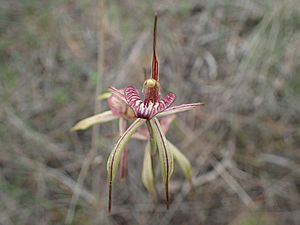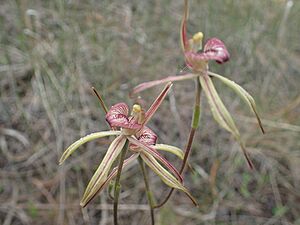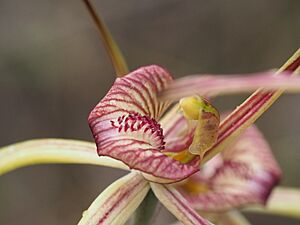Purple-veined spider orchid facts for kids
Quick facts for kids Purple-veined spider orchid |
|
|---|---|
 |
|
| Caladenia doutchiae growing in Beverley | |
| Scientific classification | |
| Genus: |
Caladenia
|
| Species: |
doutchiae
|
| Synonyms | |
|
|
The purple-veined spider orchid (scientific name: Caladenia doutchiae) is a special type of orchid. It is found only in the south-west part of Western Australia. This means it is endemic to that area.
This orchid has one fuzzy leaf. It usually grows just one flower, which is greenish-yellow and red. The flower has short petals that point downwards. Its side sepals (which look like petals) are wide at the bottom. They then get very narrow and have a tiny, sticky tip.
Contents
What Does It Look Like?
The purple-veined spider orchid is a plant that grows from the ground. It is a perennial herb, meaning it lives for more than two years. It also has an underground tuber, which is like a small storage root.
Leaves and Stems
Each orchid grows a single, straight, narrow leaf. This leaf is usually 5–15 cm (2–6 in) long and 4–6 mm (0.16–0.24 in) wide. It is also covered in tiny hairs.
Flowers
Usually, only one flower grows on a stalk that is 5–30 cm (2–10 in) tall. The flower itself is 3–5 cm (1–2 in) long and 1–3 cm (0.4–1 in) wide. Its petals point downwards and are quite short.
The side sepals are wide at their base. But they quickly become very thin, like a thread. These thin ends are covered with reddish, sticky hairs.
The labellum (which is a special lip-like petal on an orchid) is greenish-yellow with red patterns. It has a red tip and smooth edges. There is a thick, narrow line of short, red-tipped calli (small bumps) along the middle of the labellum.
When It Blooms
This orchid blooms from August to October.
Similar Orchids
The purple-veined spider orchid looks a bit like two other orchids:
- The short sepalled spider orchid (C. brevisura)
- The puppet orchid (C. incrassata)
However, you can tell Caladenia doutchiae apart because its sepals are longer. It also has a narrower band of calli on its labellum.
How It Got Its Name
The purple-veined spider orchid was first officially described in 1921. This was done by a scientist named Oswald Sargent.
He found the plant from a sample collected by Leila Doutch. She was the headmistress of a small school in Datatine. She collected the type specimen (the first plant used to describe the species) near her school.
The description of the orchid was published in a science journal called Journal of Botany, British and Foreign. The second part of its scientific name, doutchiae, honors Leila Doutch, who found the first sample.
Where It Lives
The purple-veined spider orchid grows in many different areas. You can find it between Geraldton and Ravensthorpe in Western Australia.
It likes to grow in:
- Woodlands (areas with trees)
- Shrublands (areas with bushes)
- Heath (areas with small, tough plants)
These areas are part of several biogeographic regions in Western Australia. These regions include the Avon Wheatbelt, Coolgardie, Esperance Plains, Geraldton Sandplains, Mallee, Swan Coastal Plain, and Yalgoo.
Is It Protected?
The Government of Western Australia's Department of Parks and Wildlife has looked at the purple-veined spider orchid. They have classified it as "not threatened." This means it is not currently in danger of disappearing.



